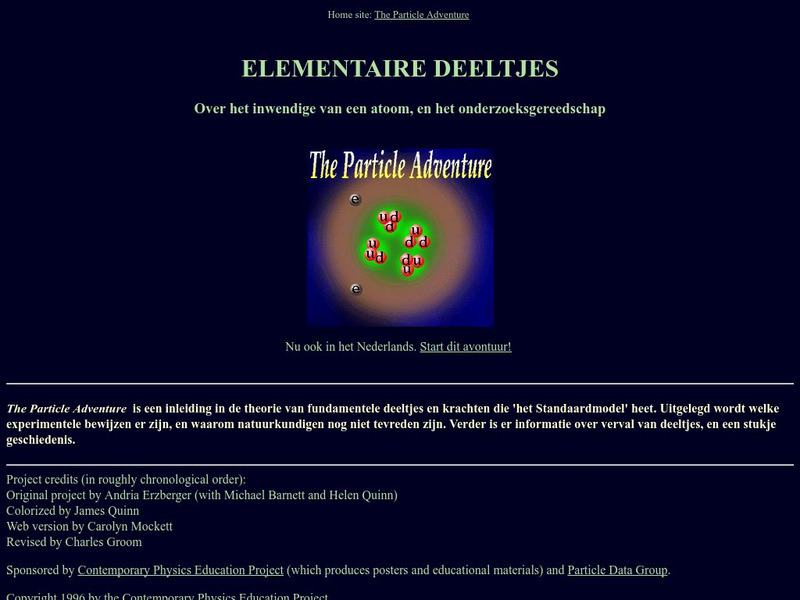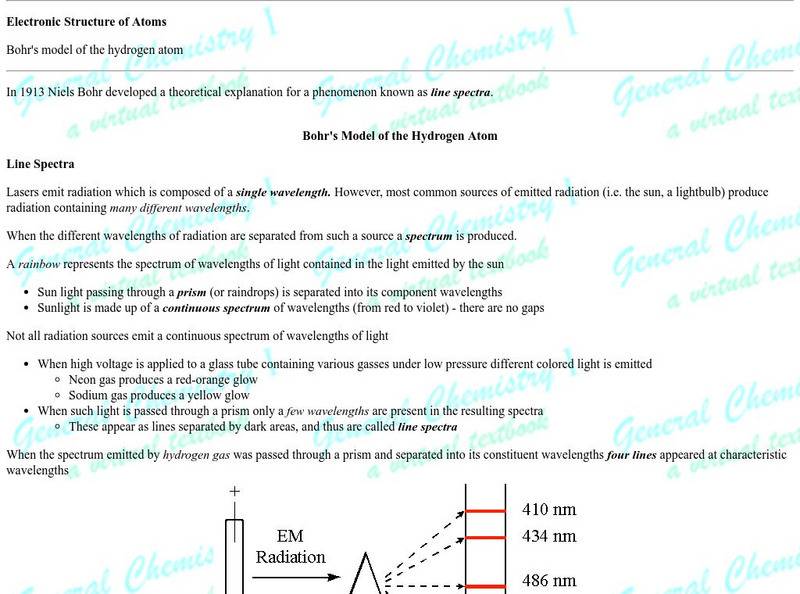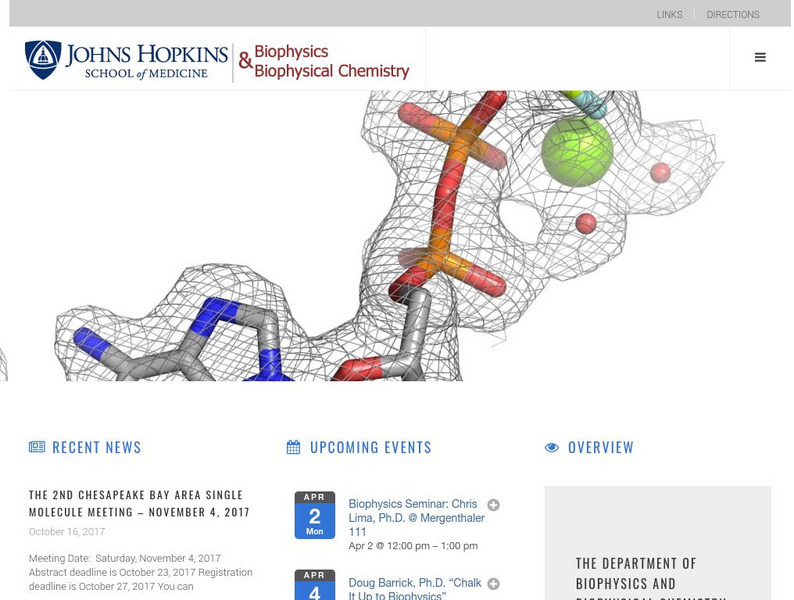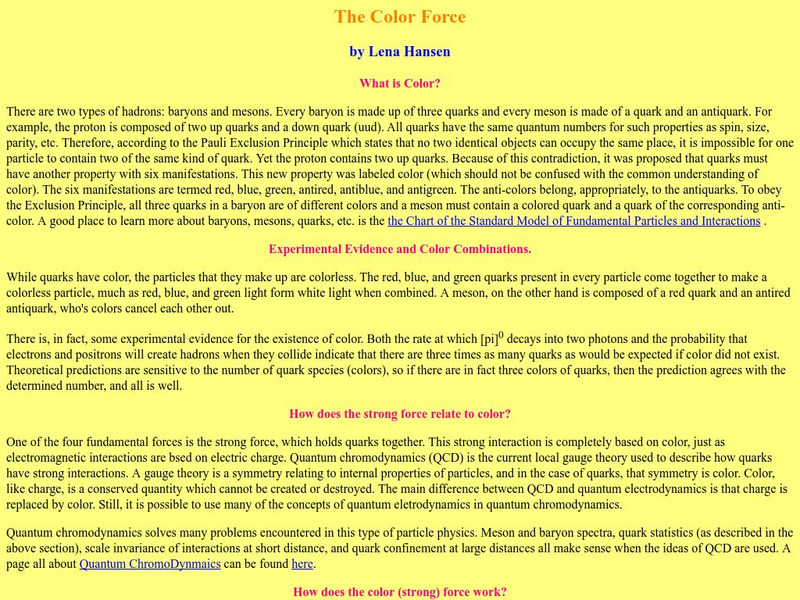Hi, what do you want to do?
Khan Academy
Khan Academy: Photoelectric Effect
Explaining the experiments on the photoelectric effect. How these experiments led to the idea of light behaving as a particle of energy called a photon.
Other
Particle Adventure Dutch Version
Dutch version of the well-known "Particle Adventure" physics website that teaches students about atoms, mass, particle physics, and quantum physics. The site discusses theories related to physics and provides other links related to the...
Michael Blaber, PhD
Florida State University: The Bohr Model of the Atom
A well designed clear tutorial explaining the energies involved in the Bohr model of the atom. Illustrations add to the clearly presented equations.
Yale University
Yale University Center for Structural Biology
This site is an excellent resource on the research and graduate studies programs in the field of biophysics.
Other
Department of Biophysics & Biophysical Chemistry
Johns Hopkins University School of Medicine site detailing ongoing research in Biophysics & Biophysical Chemistry. The site has links to courses, seminars, faculty, graduate studies, and general information.
PBS
Pbs: A Science Odyssey
Website for the PBS series "A Science Odyssey." Numerous opportunities to explore the people and discoveries of science.
National High Magnetic Field Laboratory
Magnet Academy: Julian Schwinger
Theoretical physicist Julian Schwinger used the mathematical process of renormalization to rid the quantum field theory developed by Paul Dirac of serious incongruities with experimental observations that had nearly prompted the...
National High Magnetic Field Laboratory
Magnet Academy: Sin Itiro Tomonaga
Japanese theoretical physicist Sin-Itiro Tomonaga resolved key problems with the theory of quantum electrodynamics (QED) developed by Paul Dirac in the late 1920s through the use of a mathematical technique he referred to as...
Famous Scientists
Famous Scientists: David Bohm
Learn about the life and work of quantum physicist, David Bohm, who was a leading expert in the fields of theoretical physics, neuropsychology, and philosophy.
Wikimedia
Wikipedia: The Black Hole
This site examines the black hole as an object in astrophysics. Delve into this comprehensive resource that covers this concept from its history, to qualitative physics, the reality of black holes, mathematical physics and more.
Duke University
Duke University: The Color Force
What does color have to do with particle physics? This page explains the concepts of color and the color force, which are fundamental subjects in quantum chromodynamics.
National High Magnetic Field Laboratory
Magnet Academy: Klaus Von Klitzing
Klaus von Klitzing is a Nobel laureate who won the award in 1985 for his discovery of the quantized Hall effect, sometimes referred to as the quantum Hall effect. Von Klitzing's discovery resulted from his work exploring a phenomenon...
Other
Fermi National Accelerator Lab: Discovery of Top Quark
This article announces the discovery of the top quark and its significance in particle physics.
Nobel Media AB
The Nobel Prize: Carl E. Wieman Biographical
This site from the Nobel e-Museum contains an informative autobiography of Carl E. Wieman, with a particular emphasis on his scientific achievements.
Symmetry Magazine
Symmetry Magazine: Explain It in 60 Seconds: Superconductors
Superconductors are materials that offer no resistance to electricity passing through them. They have many applications in science, such as in the Large Hadron Collider. "Explain It In 60 Seconds" is an article series that aims to...
Georgia State University
Georgia State University: Hyper Physics: Parity & Nonconservation
A really nice (and short) dual article, on Parity and on Nonconservation of Parity. With diagrams and equations, but does not overwhelm.
CK-12 Foundation
Ck 12: Physical Science: Electron Cloud Atomic Model
[Free Registration/Login may be required to access all resource tools.] Features the electron cloud atomic model and atomic orbitals.
Cosmo Learning
Cosmo Learning: Fundamentals of Chemistry
A collection of video lectures from course investigating the theory behind modern physics taught at Stanford University. The course introduces the basic concepts of particle physics by teaching about light, quantum field, Diary Equation,...
Other
Stony Brook Center for Nuclear Theory: Nuclear Theory Group
This site describes the ongoing work by the Stony Brook Center for Nuclear Theory in the field of Quantum Chromodynamics, and gives a brief definition of this concept. The site has a link to the webpage of the primary research scientist.
Other
Physics News Update: Schrodinger's Cat Ion
A report about scientist at NIST who has actually performed the Schrodinger's Cat paradox thought experiment.
Curated OER
Hyper Physics: Electron Spin
An excellent overview of electron spin, what it means in non-mathematical terms and quantum mechanical terms.
University of Illinois
University of Illinois Urbana Champaign: Theoretical Biophysics Group
Excellent and comprehensive site created by the University of Illinois at Urbana-Champaign, Beckman Institute for Advanced Science and Technology. The site has resources about and links to information on a large number of topics in...
PBS
Science Odyssey: Heisenberg States Uncertainty Principle
Explains the Heisenberg Uncertainty Principle, that it is impossible to know both the momentum and position of an electron, along with describing the impact that it made upon the scientific community upon its introduction in 1927.
Science Struck
Science Struck: Biography of Albert Einstein
The life and many accomplishments of Albert Einstein are detailed in this article. Includes descriptions of his scientific theories and contributions.






















